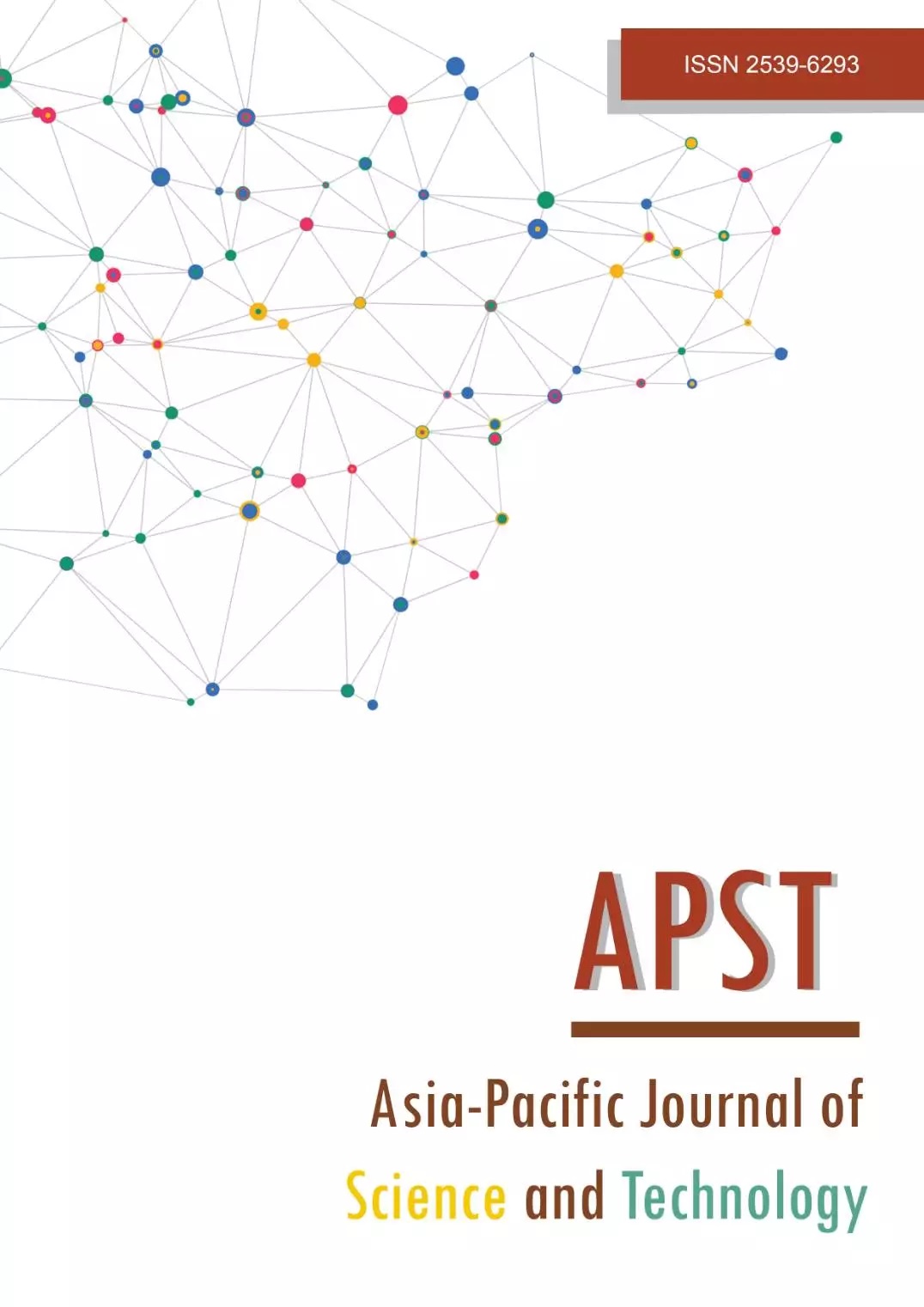Survival of probiotics Lactobacillus acidophilus TISTR1338 in a synbiotic-supplemented plant-based protein powder under various pH and temperatures
Main Article Content
Abstract
The demand of plant-based protein has been remarkably increased, leading to the development of various plant-based protein products. Supplementation of synbiotic is an effective approach to improve food function. This study aimed to develop the formulation of plant-based protein product supplemented with synbiotic which provides high survivability of probiotic through various harsh conditions. Pea protein isolate (PPI), inulin, and glycerol at ratio 2:1:1 was supplemented with probiotic strain (Lactobacillus acidophilus TISTR1388) to develop as encapsulated synbiotic plant-based protein powder (SPBP). The developed formulation provided probiotic survival rate after freeze-drying and gastro-intestinal (GI) tract conditions at 95.0±2.1% and 62.4±6.1%, respectively. Whereas, probiotic as free-cells showed survival rate after freeze-drying at 78.9±0.4% and no survival cell was observed after GI tract digestion. Scanning Electron Microscope (SEM) analysis demonstrated SPBP's remarkable capacity to perfectly entrap probiotic cells with no visible cell damage. Herein, the stability of the SPBP was tested through various pH levels (3, 5, 7, and 9) and temperature levels (6±2°C, 26±2°C, and 55±2°C) in order to investigate the possibility of applying this product to various food categories. Results showed that developed SPBP survived through all tested pH and temperature levels for 3 h at least 88.9±6.6%. Shelf-life evaluation showed that SPBP provided survival rate of probiotic cells up to 96.2±2.4% an aw of 0.09±0.01 after 12 weeks of refrigerated storage. Overall, results revealed that SPBP had a strong possibility of being employed as a probiotic stabilizer that may be further developed for a functional food product.
Article Details

This work is licensed under a Creative Commons Attribution-NonCommercial-NoDerivatives 4.0 International License.
References
Mallappa RH, Rokana N, Duary RK, Panwar H, Batish VK, Grover S. Management of metabolic syndrome through probiotic and prebiotic interventions. Indian J Endocrinol Metab. 2012;16(1):20-27.
Yoha KS, Nida S, Dutta S, Moses JA, Anandharamakrishnan C. Targeted delivery of probiotics: perspectives on research and commercialization. Probiotics Antimicrob Proteins. 2022;14(1):15-48.
Petsong K, Kaewthong P, Kingwascharapong P, Nilsuwan K, Karnjanapratum S, Tippayawat P. Potential of jackfruit inner skin fibre for encapsulation of probiotics on their stability against adverse conditions. Sci Rep. 2023;13(1):11158.
Agri-food Innovation Council Conseil de I'innovation agroalimentaire. Plant-based protein market global and canadian market analysis [Internet]. 2019 [cited 2023 April 20]. Available from: https://nrc.canada.ca/sites/default/files/2019-10/Plant_protein_industry_market_analysis_summary.pdf.
Akhtar S, Ismail T, Layla A, Hussain M, Qamar M. An overview of plant-based protein rich products. In: Manickavasagan A, Lim LT, Ali A, editors. Plant protein foods, Springer Cham; 2022. p. 27-60.
Food and Agriculture Organization of the United Nations (FAO). The need for guidance on alternative proteins highlighted to codex alimentarius commission [Internet]. 2022 [cited 2023 April 20]. Available from: https://www.fao.org/in-action/sustainable-and-circular-bioeconomy/resources/news/details/en/c/1507553/.
Lu ZX, Heb JF, Zhanga YC, Bing DJ. Composition, physicochemical properties of pea protein and its application in functional foods. Crit Rev Food Sci Nutr. 2019;60(15):1-13.
Petsong K, Benjakul S, Vongkamjan K. Optimization of wall material for phage encapsulation via freeze-drying and antimicrobial efficacy of microencapsulated phage against Salmonella. J Food Sci Technol. 2021;58(5):1937–1946.
Teferra TF. Possible actions of inulin as prebiotic polysaccharide: a review. Food Frontiers. 2021;2:407–416.
Koh CM. Storage of bacteria and yeast. Methods Enzymol. 2013;533:15-21.
Bhattacharya S. Cryoprotectants and their usage in cryopreservation process. In: Bozkurt Y, editor. Cryopreservation biotechnology in biomedical and biological sciences, London: IntechOpen; 2018.
Petsong K, Benjakul S, Vongkamjan K. Evaluation of storage conditions and efficiency of a novel microencapsulated Salmonella phage cocktail for controlling S. Enteritidis and S. Typhimurium in-vitro and in fresh foods. Food Microbiol. 2019;83:167-174.
Ryan L, O'Connell O, O'Sullivan L, Aherne SA, O'Brien NM. Micellarisation of carotenoids from raw and cooked vegetables. Plant Foods Hum Nutr. 2008;63(3):127-133.
Tokio N, Tadashi A, Tadao M. The mechanism of cellular injury by freezing in microorganisms. International Conference on Low Temperature Science I. Conference on Physics of Snow and Ice, II. Conference on Cryobiology; 1966 Aug 14-19; Sapporo, Japan. n.p.; 1967. p. 157-169.
Burca-Busaga CG, Betoret N, Seguí L, Betoret E, Barrera C. Survival of Lactobacillus salivarius CECT 4063 and stability of antioxidant compounds in dried apple snacks as affected by the water activity, the addition of trehalose and high pressure homogenization. Microorganisms. 2020;8:1095.
Yu Q, Wenqiong W, Xian L, Wenwen Sh, Ruixia G, Congcong T. The antioxidant activity and protection of probiotic bacteria in the in vitro gastrointestinal digestion of a blueberry juice and whey protein fermentation system. Fermentation. 2023;9(4):335.
Wan Z, Fei T, Wang T. Inhibition of ice crystal growth by protein hydrolysates from different plant- and animal-based proteins. Food Materials Research. 2022;2(1):1-9.
Jiménez-Munoz L, Nielsen MT, Roman L, Corredig M. Variation of in vitro digestibility of pea protein powder dispersions from commercially available sources. Food Chem. 2023;401:134178.
Raddatz G, Fonseca B, Gabriela P, Eduardo JL, Alexandre C, Edson M, et al. Influence of the prebiotics hi-maize, inulin and rice bran on the viability of pectin microparticles containing Lactobacillus acidophilus LA-5 obtained by internal gelation/emulsification. Powder Technology. 2019;362:409-415.
Shori AB, Baba AS, Muniandy P. 5 - Potential health-promoting effects of probiotics in dairy beverages. In: Grumezescu AM, Holban AM, editors. Value-added ingredients and enrichments of beverages, n.p.: Academic Press; 2019, p. 173-204.
Legrand J, Guéguen J, Berot S, Popineau Y, Nouri L. Acetylation of pea isolate in a torus microreactor. Biotechnol Bioeng. 1997;53:409-414.
Mession J-L, Chihi ML, Sok N, Saurel R. Effect of globular pea proteins fractionation on their heat-induced aggregation and acid cold-set gelation. Food Hydrocoll. 2015;46:233-243.
Dewanjee S, Chakraborty P, Dey A, Bhattacharya H, Bhattacharyya C, Sanyal R, et al. Plant polysaccharides for colon-targeted drug delivery. In: Nayak AK, Hasnain MS, Pal D, editors. Plant polysaccharides as pharmaceutical excipients, n.p.: Elsevier; 2023, p. 329-368.
Desvaux M, Dumas E, Chafsey I, Hébraud M. Protein cell surface display in Gram-positive bacteria: from single protein to macromolecular protein structure. FEMS Microbiol Lett. 2006;256(1):1-15.
Fellows PJ. Food processing technology: principles and practice. 3rd ed. n.p.: Woodhead Publishing; 2009.


